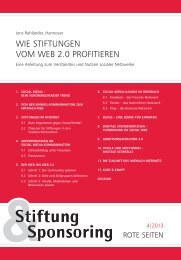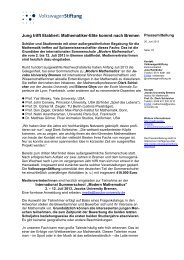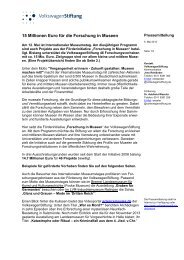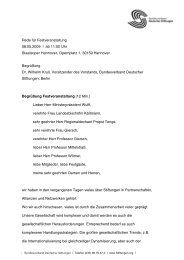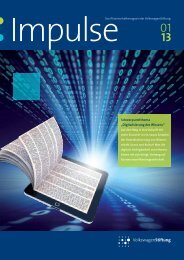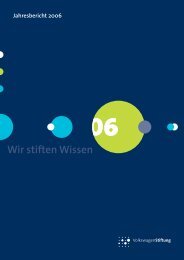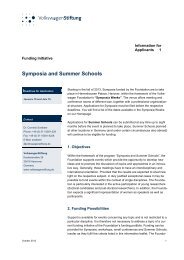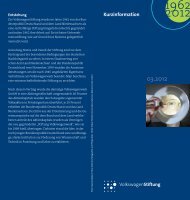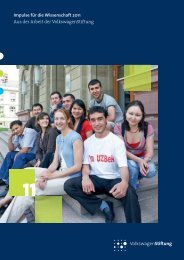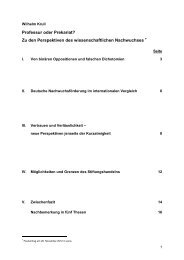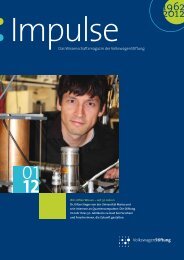Bewilligungen im Jahr 2008 - Volkswagen Stiftung
Bewilligungen im Jahr 2008 - Volkswagen Stiftung
Bewilligungen im Jahr 2008 - Volkswagen Stiftung
Erfolgreiche ePaper selbst erstellen
Machen Sie aus Ihren PDF Publikationen ein blätterbares Flipbook mit unserer einzigartigen Google optimierten e-Paper Software.
Fellowships Computational Sciences<br />
Berlin<br />
Hydrogen-bond network in protein folding<br />
Bewilligung: 30.06.2011 Laufzeit: 3 <strong>Jahr</strong>e<br />
- 128 -<br />
Detailed atomistic models of proteins can only be used to study short t<strong>im</strong>es, and thus can<br />
involve only very l<strong>im</strong>ited conformational changes in large systems. They are also of little use<br />
for understanding general principles of proteins and how complex macroscopic properties<br />
emerge from elementary interactions. Coarse grained models are used to overcome these<br />
problems. However, such models fail to describe many properties of proteins, like the phase<br />
diagram of these macromolecules and the forces favoring the formation of secondary structures.<br />
The project´s goal is to overcome these l<strong>im</strong>itations and to construct a protein model that contains<br />
the correct thermodynamics and topology of real proteins, but is still s<strong>im</strong>ple enough to<br />
reveal general principles. The approach differs from previous attempts in the use of the hydrogen<br />
bonding network as the framework within which the protein folding problem will be formulated.<br />
Freie Universität Berlin<br />
Fachbereich Physik<br />
Dr. Cristiano Dias<br />
Arn<strong>im</strong>allee 14<br />
14195 Berlin<br />
Freie Universität Berlin<br />
Fachbereich Physik<br />
Dr. Markus Miettinen<br />
Arn<strong>im</strong>allee 14<br />
14195 Berlin<br />
____________<br />
Göttingen<br />
Signal propagation in networks of cortical neurons<br />
Bewilligung: 18.03.2011 Laufzeit: 3 <strong>Jahr</strong>e<br />
How do neurons within recurrent cortical networks respond to dynamical signals? Can<br />
networks of threshold neurons describe the activity of networks in vitro? These <strong>im</strong>portant,<br />
yet unresolved, questions will be the main focus of this fellowship. A combination of<br />
analytical and numerical techniques within the theoretical framework of correlated<br />
Gaussian processes is used for numerical network s<strong>im</strong>ulations with a predefined<br />
structure and interactions. During a two-year stay at the Center for Theoretical<br />
Neuroscience, Columbia University, New York, the focus is on signal processing in<br />
recurrent networks of threshold neurons. The interaction of st<strong>im</strong>ulus evoked and intrinsic<br />
activity is studied in order to reveal the biophysical basis of signal relay in cortical<br />
neurons. Back in Germany, the opportunity to directly probe the theoretically predicted<br />
dynamical network responses in a closed-loop opto-genetically controlled network is<br />
seized. The expected contribution refers to the computational side. Analytical model<br />
predictions are derived for validating and refining the model assumptions.<br />
Max-Planck-Institut für exper<strong>im</strong>entelle Medizin, Göttingen<br />
Abteilung für Molekulare Biologie neuronaler Signale<br />
Dr. Tatjana Tchumatchenko<br />
Hermann-Rein-Straße 3<br />
37075 Göttingen<br />
Tel.: 0551 3899-550<br />
____________



